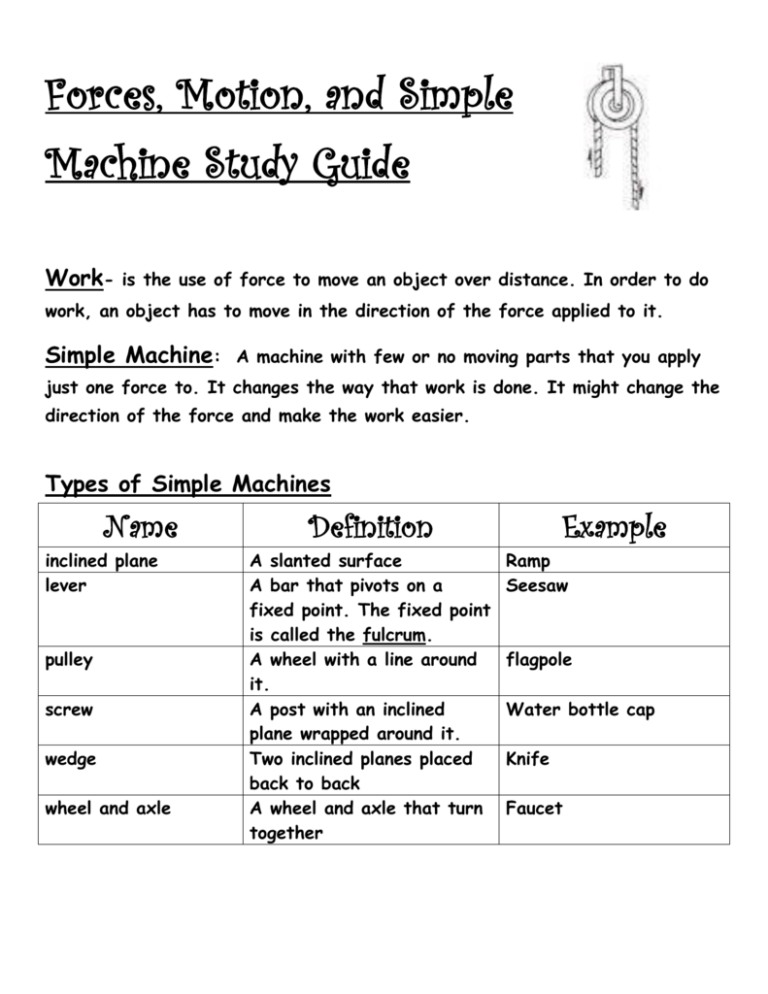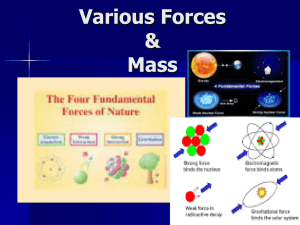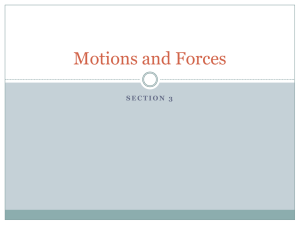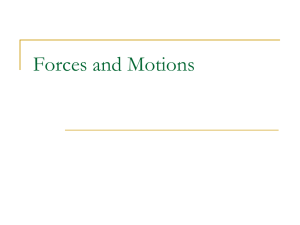Forces and Motion Study Guide
advertisement

Forces, Motion, and Simple Machine Study Guide Work- is the use of force to move an object over distance. In order to do work, an object has to move in the direction of the force applied to it. Simple Machine: A machine with few or no moving parts that you apply just one force to. It changes the way that work is done. It might change the direction of the force and make the work easier. Types of Simple Machines Name inclined plane lever pulley screw wedge wheel and axle Definition A slanted surface A bar that pivots on a fixed point. The fixed point is called the fulcrum. A wheel with a line around it. A post with an inclined plane wrapped around it. Two inclined planes placed back to back A wheel and axle that turn together Example Ramp Seesaw flagpole Water bottle cap Knife Faucet Motion- How is it defined and how is it measured? Position is the location of an object. An object can change position. We call this change motion. Speed tells us how the position of an object changes over a certain amount of time. In order to measure speed, you need to know how far the object moved and the amount of time it took the object to go that distance. Speed = distance ÷ time. Example: A car travels 240 miles over 6 hours. The division problem is 240 ÷ 6. So, the car traveled at 40 miles per hour. The speed of the car is 40MPH. Acceleration is any change in the speed or direction of an object’s motion. Forces- How do forces affect motion? Force is a pull or a push that causes an object to move, stop, or change direction. If more force is applied….there will be more change in acceleration.) Gravity -How does gravity affect motion? Gravity is the force of attraction between Earth and other objects. The larger and closer two objects are to each other, the more gravity affects them. In order to produce motion of an object, enough force has to be applied to overcome the gravitational force. Weight- How does weight affect motion? Weight is the gravitational force acting on an object. It is simply how we measure the force of gravity on an object. The more an object weighs, the more force will be needed to produce motion of that object. Mass is different from weight. It is the amount of matter in an object. Weight can change. Mass is a constant and does not change. Friction-How does friction affect motion? Friction is a force that resists motion between objects that are touching. Over time, friction slows down motion and stops it. Example: Your bike slows down when you apply the brakes. The rubber brake pads are pushing against the wheels. Inertia- How does inertia affect motion? Inertia-is the property of matter that keeps it moving in a straight line and keeps unmoving matter at rest. The more mass an object has, the more inertia it has. That means as the mass increases, it will be harder to change its motion. Think of how much harder it is to move a box full of books than the same size box when it is empty. Glossary acceleration direction force friction fulcrum gravity Any change in the speed or direction of an object’s motion. The line or course along which someone or something moves. A pull or a push that causes an object to move, stop, or change direction. (More force….more acceleration.) A force that resists motion between objects that are touching. The fixed balance point on a lever. mass The force of attraction between Earth and other objects. The property of matter that keeps an object at rest or moving in a straight line. The amount of matter in an object. motion A change in the position of an object. position The location of an object. speed weight The measure of the change in an object’s position in a unit of time. Speed= distance divided by time. Speed = distance÷ time The measure of gravitational force acting on an object. work The use of force to move an object over a distance. inertia











